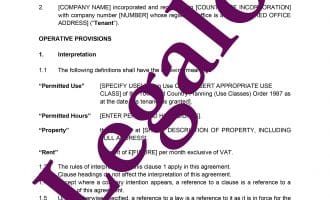Tenancy at Will
Our Tenancy At Will template:
- Expertly drafted in the UK by a solicitor
- Easy to complete with full guidance notes
- Cost-effective legal reliability
- For a simple, short agreement
- Now over 100 sold!

How Does It Work?
-
1. Download
-
2. Edit
-
3. Print
-
4. Sign
This is our standard template for a Tenancy at Will. It is designed to be used when you want to put in place an informal tenancy for the short-term letting of commercial property. You can easily customise it to suit your individual requirements. It comes with a guide to help you. It is for property in England and Wales, but not Scotland.
If you are looking for a similar short-term informal tenancy agreement, but for residential property, then please have a look at our Licence to Occupy Residential Property template.
The template has been drafted by David, our co-founder and lawyer of over twenty-five years. This ensures that you can rely on the document being up-to-date and legally comprehensive. Our detailed guidance notes (free with the template) offer a clause-by-clause explanation of the Tenancy At Will and make completing the final document simple and fast. A copy of the guidance notes are available here: guide to this template.
Now over 100 sold!

Using our template
Download this template in Word format at the click of a button once purchased. It comes along with a guide on completing the template. You can then quickly edit the template to adapt it to your own needs. With the guide to help you, we are sure you will find this simple process.
You can also contact us by email or use our free helpline for support if you have any queries on how to use the template or complete it: contact us.
We provide a full money-back guarantee if you aren’t happy with your template document for any reason.
Once purchased, you can reuse the template to create additional Tenancies at Will at no further cost. We keep our templates under review to ensure they are up-to-date. When we update a template that you have bought, we will notify you by email and you will get access to the updated template for free.
How and when to use our template
Our Tenancy at Will template is for use by a landlord to let commercial premises (or part of it) to a tenant for a short informal period. For more information on this, please see our guide to this template.
For Investopedia’s take on a tenancy at will see: https://www.investopedia.com/terms/t/tenancy-at-will.asp.
If you would like to see our other commercial property templates click on the link.

FAQs about Tenancies at Will
Below, we address the most popular questions from the Internet about tenancies at will.
What is a tenancy at will agreement?
A tenancy at will agreement is a type of arrangement that allows a commercial tenant to use a property for an indefinite period without a formal commercial lease. It is a more flexible and informal option resulting in a simpler agreement between landlord and tenant. In this agreement, a commercial tenant can occupy a property for as long as the landlord agrees, with either party having the right to terminate the contract with relatively short notice. It can be a less stable option, but is useful in a situation in which flexibility is preferred.
What is an example of a tenancy at will?
A tenancy for an indefinite term is an example, and that is a key feature of such a tenancy. It will only be used in the commercial context though – it is not for residential properties.
How do I make a tenancy at will?
To create a tenancy at will, the landlord and tenant need to agree on the arrangement’s terms, including details like rent and a termination notice period. The potentially informal nature of this agreement means that it can be verbal, but it is advisable to outline the terms in writing to avoid any misunderstandings or disputes in the future.
You can download our easy-to-use template for the fraction of the cost of hiring a solicitor, while being safe in the knowledge that your final agreement will be legally sound.
Can a tenancy at will be verbal? Does a tenancy at will need to be in writing?
It can, but, as with any legal contract, it is silly not to put it in writing. If anything goes wrong with a verbal contract, proving it in evidence is very difficult. A verbal agreement provides limited protection for both parties in comparison to a written agreement, as it can be more difficult to prove the terms and conditions on which you agreed. Misunderstandings are also more common with a verbal agreement, so a dispute is more likely to arise. This is why it is always recommended to draft a written agreement for any legally binding contract whether with a stranger or a close friend.
Can I write my own tenancy agreement in the UK? Do I need a solicitor to draw up a tenancy agreement? Can I download a tenancy agreement form?
Yes, you can write your own tenancy agreement without the need for a solicitor. But since you can do it for a reduced cost right here on Legalo, why take the risk of writing it yourself? Our downloadable templates really make your life easier when you need a legal contract. Just download our great template and fill in all of the necessary details for your situation, and the resulting document will be legally binding and comprehensive.
Can a tenancy agreement be handwritten?
Yes, a tenancy agreement can be handwritten. While a typed or printed agreement is often preferred for clarity and professionalism, a handwritten agreement can also be legally binding, provided it contains all the necessary terms and conditions agreed upon by both the landlord and tenant.
However, with the availability of our great template, it makes no sense to write one out by hand. You just need to fill ours in on your computer, print it, sign it and date it.
How long is a tenancy at will?
A tenancy at will is an arrangement without a fixed duration. It can therefore continue for as long as both the landlord and tenant agree to maintain it. However, since it’s a flexible and informal arrangement, either party can usually terminate the tenancy at will with relatively short notice, the period for which is usually agreed upon in advance.
It is not for a fixed term, minimum term or a set period. As soon as you make it for a minimum term of 6 months or more, then it becomes a commercial lease and the rules in the Landlord and Tenant Act 1954 apply. For example, this would then include the right for the tenant to renew the lease when it expires.
How do you terminate a tenancy at will?
A key feature of a tenancy at will is that it is terminable at any time on proper notice. You should set what that notice period is in the tenancy at will, but it is usually a fairly short period.
When terminating a tenancy at will, you must give notice to the other party, whether the landlord or tenant. We recommend you to follow a few steps in the process of terminating a tenancy at will:
- Review the Agreement: check the minimum notice period required for the termination notice.
- Provide written notice: regardless of the length of the notice period given, written notice can help to avoid misunderstandings or disputes during a termination.
- Deliver the notice: you can usually do this in person, by mail, or electronically (e.g. via email). However, check if the tenancy agreement specifies how.
- Respect Notice Period: allow the required and agreed upon notice period to pass before the termination comes into effect.
- Vacate the property: if you are the tenant, it is important to vacate the property before or on the agreed termination date. Leave it clean and in an appropriate condition.
- Inspect property: If you are the landlord, inspect the property for any damage once the tenant has left. However, the landlord cannot generally charge the tenant for fair wear and tear.
What is the difference between a tenant and a tenant at will?
A tenant under a fixed-term lease of over 6 months has the right:
- to renew the lease on expiry for the same term and on the same terms;
- but at whatever the market rate of rent is at that time.
This is a right under the Landlord and Tenant Act 1954, which applies unless the tenant has contracted out of it. The tenant can take the landlord to court if it does not like the landlord’s suggestion of the new rate of rent. That is a convoluted process and, as a result, 99% of landlords get the tenant to contract out of the right to renew. The other 1% generally only don’t contract out because either:
- hey have forgotten to;
- they do not understand the process; or
- they have created a protected tenancy when they did not mean to. Perhaps they thought it was just a licence to occupy.
A tenancy at will does not create the same right for the tenant to renew the tenancy on expiry, but it must be:
- for an indefinite term; and
- not with any minimum term exceeding 6 months.
What are the dangers of a tenancy at will?
The dangers are that:
- it lacks the legal structure and protections of a formal lease agreement (this could be worse for the landlord);
- you might not put it in writing; or
- you create it for a fixed term of over 6 months, in which case you will have turned it into a lease and will have failed to contract out of the tenant’s right to renew that lease on its expiry.



